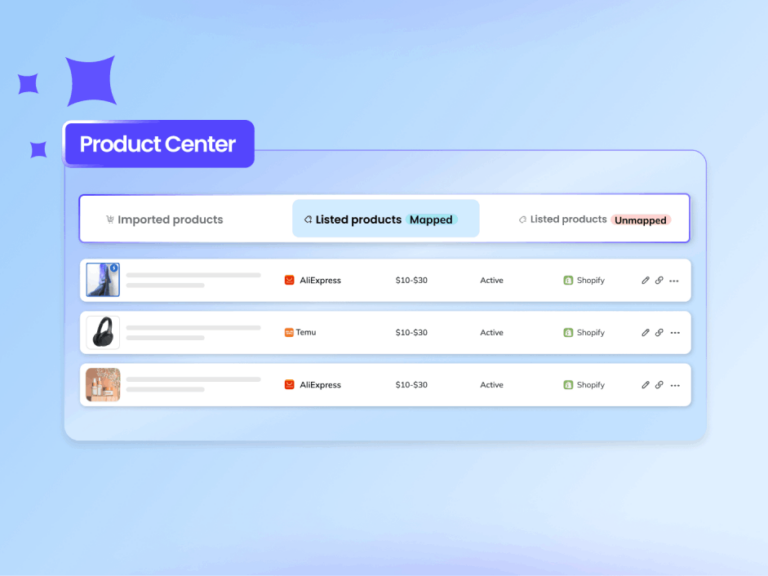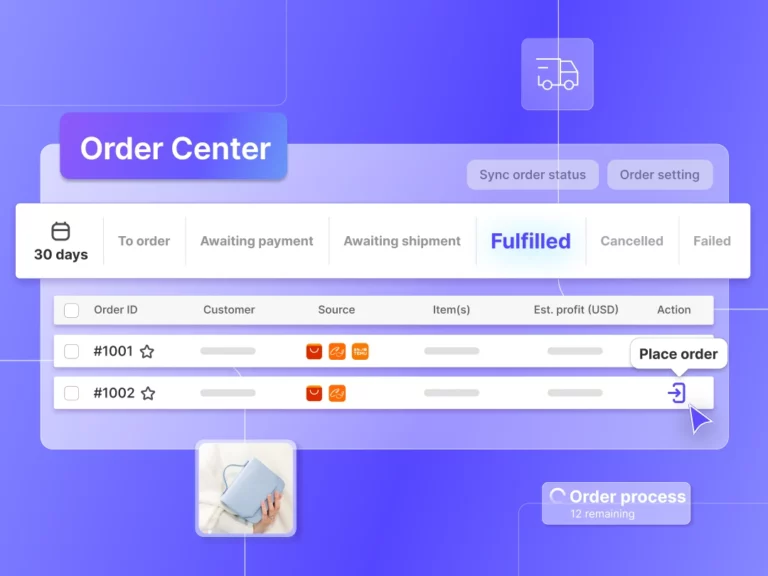Dropshipping Market Research: Trends, Statistics & Forecast

Dropshipping takes up around 30% of online stores and is growing as a cost-effective business model. It penetrates and grabs the attention of worldwide entrepreneurs for specific reasons.
We’ve scanned numerous dropshipping market research reports to determine what’s noteworthy. Whether you’re a wholesaler or a dropshipper, this post is a must-read.
We’ll show you need-to-know dropshipping trends, statistics, and forecasts below. Let’s see if the market is your fertile land!
📌 Key takeaway:
- Dropshipping is booming globally, valued at USD 225.99 billion in 2022, with a projected CAGR of 23.4% from 2023 to 2030.
- Fashion leads, with electronics, toys, furniture, and food following closely, showcasing a diverse market landscape.
- Asia Pacific is the dropshipping leader, with North America following, projecting a USD 1,560.00 billion revenue by 2027.
- Tech advancements offer opportunities, but challenges include constant product sourcing, secure transactions, fast delivery demands, and adapting to global events like COVID-19. Entrepreneurs must navigate these for sustained success.
What is Dropshipping & How Does it Work?
Dropshipping is an online business model that does not require inventory, packaging, or shipping.
An online store is set up and products from a supplier are listed. The order details are passed to the supplier when a customer buys a product from the store. The supplier ships the product directly to the customer.
As a go-between, you sell the product at a retail price, pay the product cost to the supplier after a successful order, and keep the profit.
You primarily plan and execute sales and marketing. You also provide customer service to ensure buyers are happy, maintaining a reasonable retention rate.
So basically, dropshipping is a profitable business idea (depending on your niche). It may require a budget to run the online store and advertising, but at least you don’t own product capital. You earn for each conversion you make.
That’s how dropshipping works.
Now let’s delve into the dropshipping market research data!
What is The Overall Dropshipping Market Size?
The total sales in the dropshipping market have been increasing steadily. In 2022, the global dropshipping market was already worth USD 225.99 billion. This figure flourishes in the coming years, with the data pointing toward continued and rapid increase.
Here’s a more specific look.
- The number of businesses involved in dropshipping is going up. Around 27% of online retailers have adopted dropshipping. As e-commerce leaps, this indicates a massive crowd of firms in this sector.
- Of course, there must be a high demand. The number of consumers engaging with dropshipping businesses has also increased. There were about 2.14 billion digital buyers globally in 2021. And many of them likely interacted with dropshipping companies.
- That causes numerous wholesale suppliers to appear more. They see the benefits of working with dropshippers, including increased profits. Several lists detail top dropshipping suppliers to show a healthy supplier base for this industry.
- The future of this market looks bright with a favorable forecast. According to projections, the global dropshipping market will experience a compound annual growth rate (CAGR) of 23.4% between 2023 and 2030.
Many factors propel this growth. One of them is the rising trend of cross-border e-commerce trade. It comes from the increased disposable income and preference for online shopping.
Dropshipping is getting more popular because it requires merchants less in logistics. In exchange, they have more time to be creative in selling and marketing. The inventory and delivery tasks are left to professionals only.
Plus, a diverse portfolio of products has contributed to dropshipping growth. This comes from the fact that people are inclined toward a more intelligent life, leading to many new demands.
In general, the global dropshipping market is thriving and shows no signs of slowing down.
Dropshipping Market Research by Product Category
The dropshipping market research classifies products into six categories as below:
- Electronics and Media
- Fashion
- Toys
- Hobbies and DIY
- Furniture and Appliances
- Food and Personal Care
1. Fashion
Fashion is the largest dropshipping segment. And it’s projected to proliferate from 2023 to 2030 due to the increasing globalization and changes in consumer behaviors. The category is estimated to reach the most prominent CAGR of 24.8% during the forecast period.
People’s buying decisions for fashion dropshipping products have changed. Many consumers, especially GenZ, don’t follow the traditional sales funnel. Instead, they have complex buying journeys where they may jump between different stages before purchasing.
These behaviors make social e-commerce apps like TikTok or Instagram more advantageous. Brands can create content to entertain people and sell directly on these platforms. The audience tends to buy instantly once they’re convinced by it.
Also, selling clothes online would be much easier for brands. They can reach a wider global audience without partnering with distributors or local stores. All sale channels can be managed online from a single point.
2. Electronics
Electronics is the second largest product segment in dropshipping. It took up around 20% market share in 2022 and continues rising. The reason for this can be credited to technological progress and the widespread availability of intelligent gadgets. They undoubtedly are smartphones, smartwatches, Bluetooth speakers, headphones, and other similar devices.
Plus, big marketplaces like Amazon, AliExpress, and eBay support the sales of electronic products. Thus, customers can compare many products and benefit from discounts and returns.
3. Toys and Hobby & DIY
Toys and Hobby & DIY represent approximately one-sixth of the market share as the third largest. Dropshipping market research experts estimate the segment value to reach USD 230.64 billion by 2028 at a CAGR of 7.30% from 2021 to 2028.
During the pandemic, games related to education and construction activities have become increasingly popular among children. Additionally, there’s a growing awareness about mental health and the role of toys in child development.
4. Furniture & appliances
Furniture made up over 17% of total e-commerce sales in 2021 and has increased since. The global furniture market is predicted to reach $718.3 billion by 2025. These statistics indicate a positive growth trajectory for the segment.
Online furniture stores allow people to browse a diverse product portfolio from home. And without carrying inventory and shipping, dropshippers feel more secure selling bulky items internationally.
5. Food & personal care
Although food and personal care products have a smaller market share, their growth has not been slow.
The global organic food and beverage market was valued at USD 208.19 billion in 2022. It’s projected to have a compound annual growth rate (CAGR) of 11.7% from 2023 to 2030 due to the increasing trend of healthy living. Consequently, more dropshippers are entering this category.
Additionally, the rise of e-commerce has made it easier for people to purchase personal care items through mobile applications. As this segment affects consumer health, buyers are ensured with online testimonials or customer reviews.
Dropshipping Market Research by Region
1. Asia Pacific – the world’s largest dropshipping region
E-commerce is a booming industry in Asia Pacific (APAC), the world’s leading region for online sales. In 2022, the region’s e-commerce revenue is expected to reach USD 3,323.19 billion, far surpassing any other area.
China, India, Japan, Australia, and South Korea are the big players in the APAC’s e-commerce market. Their impressive growth is driven by several factors, such as:
- A large and growing middle class with higher disposable income and online shopping preferences. APAC has the world’s biggest and fastest-growing middle-class population. This group can access the internet and shop online easily with their smartphones.
- A supportive government policy and regulation for e-commerce development. Many APAC countries, such as China and India, are significant global manufacturers. Their governments provide financial assistance for infrastructure for e-commerce businesses to thrive.
- A diverse and abundant product offering from various e-commerce platforms. Consumers can find multiple products online, from clothing and electronics to food and home appliances. For example, Alibaba offers millions of products across different categories.
- A reliable and efficient logistics infrastructure that enables fast and convenient product delivery. This allows dropshipping companies to focus on crucial marketing activities to generate leads.
- A high social media penetration that stimulates consumer demand. APAC has the highest number of social media users worldwide, influenced by online trends and recommendations.
These factors have made dropshipping a popular and profitable business model in the region.
2. North America – the world’s second-largest dropshipping region
North America is the second-largest region in the e-commerce market, with a projected revenue of USD 1,560.00 billion by 2027, growing at a CAGR of 11.23%. The market is mature and highly competitive in the US and Canada, where e-commerce players incur high costs to gain an edge.
One of the key drivers of the e-commerce market in North America is artificial intelligence (AI). AI helps online businesses improve customer service by providing product recommendations and facilitating orders. AI also helps dropshipping companies optimize inventory management and marketing. For example, AI can alert suppliers about stock shortages and help sellers create effective lead-generating campaigns.
However, the e-commerce market in North America is less integrated than in developing countries. Consumers in North America have different preferences and expectations regarding payments, digital shopping, and online privacy. Therefore, e-commerce businesses must adapt to these factors to succeed in the region.
Opportunities & Challenges for Dropshipping Businesses
The dropshipping market research analyzed point to similar reasons for the industry’s growth. They show the magnitude of the opportunities and the particular challenges.
1. Opportunities
The proliferation of technology has made dropshipping a quick and fast-moving profit-making business. Smartphones and tablets have revolutionized online shopping. It comes with numerous mobile applications to make the consumer experience pleasant and convenient.
Moreover, technology gave birth to various marketplaces and e-commerce platforms. These online destinations create endless space for consumers to shop and get post-purchase support.
As a dropshipper, you can select wholesale partners from millions of suppliers on huge sites. They include Shopify, AliExpress, Doba, SaleHoo, and more. If you’re a wholesaler, these platforms can help you connect with worldwide retailers.
Other elements anticipated to boost market expansion include lower overhead expenses and a diverse product portfolio.
2. Challenges
For dropshippers, the never-ending task of sourcing new products can be challenging. The typical lifespan of dropshipping products is approximately 60 months. Launching new products is a must once a product reaches saturation point.
Dropshippers also face the challenge of ensuring payment transactions are safe and secure. Cyber threats and security breaches are risky since payment gateways can be vulnerable. This poses a significant challenge for the industry.
What’s more, today’s consumers love fast delivery. To have a reasonable retention rate, hence, sellers must first provide the best shipping service. In dropshipping, this traits back to the supplier-outsourcing stage.
Global events like the COVID-19 pandemic are also considered a significant threat to the e-commerce industry. The factory shutdowns and trade bans among nations have had significant impacts.
Top Dropshipping Companies
With the rise of dropshipping, more and more firms have entered the battle of supplying products. Dropshipping market research experts consider these companies as significant players in the industry:
- AliDropship: a US-based dropshipping platform that helps users create online stores and source products from AliExpress. It has 10 years of experience in dropshipping SaaS and offering premium products to sell.
- Shopify: an e-commerce platform based in Canada that also helps you with store development and dropshipping. The company reached around USD 5.6 billion in total revenues in 2022.
- SaleHoo Group Limited: a directory service that was launched in New Zealand in 2005. Since its founding, SaleHoo has developed into a directory covering over 8,000 wholesale and suppliers.
- Printify: a leading print-on-demand company that offers dropshipping and printing services for e-commerce. The company is trusted by over 4 million sellers worldwide and has an estimated revenue of USD 80.5 million annually.
- AliExpress: a massive online marketplace owned by the Alibaba Group. It was established in 2010 and has grown significantly since then. It has over 150 million unique users and 100 million products for sale.
Conclusion
The dropshipping market is a dynamic and rapidly evolving industry. Its global market size is expanding, driven by the increasing adoption of e-commerce and the growing trend of online shopping.
The market analysis reveals significant variations based on products and regions. This offers unique opportunities for businesses to cater to specific niches and demographics. However, the industry also presents its own set of challenges that companies must navigate to succeed.
Nevertheless, prominent companies in the dropshipping industry are setting the pace with innovative solutions. They’re shaping the industry and providing valuable insights into the market’s future direction.
As we move forward, entrepreneurs must acknowledge these dropshipping market research statistics. This will enable them to make strategic initiatives, seize opportunities, and overcome challenges in dropshipping.
Considering the data shown, the future of dropshipping looks promising. And those who can adapt to its changing landscape will be well-positioned to thrive.






